Frédéric Soulacroix stands as a distinguished figure in the realm of late 19th and early 20th-century academic painting. A Franco-Italian artist, he became renowned for his exquisite portrayals of elegant figures in luxurious interiors, often evoking the romanticism and opulence of a bygone era, particularly the 18th century, or the refined sensibilities of his own time. His meticulous attention to detail, especially in the rendering of rich fabrics like silk and satin, earned him a dedicated clientele and a lasting place among the masters of genre and portrait painting. This exploration delves into his life, artistic development, signature style, key works, and his position within the broader context of European art history.
Early Life and Artistic Formation
Born in Rome in 1858, Frédéric Soulacroix was immersed in an artistic environment from his earliest years. His father, Charles Soulacroix (1825-1899), was a respected painter and sculptor, known for his historical and allegorical works. This paternal influence undoubtedly played a crucial role in nurturing young Frédéric's artistic inclinations. Growing up in a household where art was not just a profession but a way of life provided him with an invaluable foundation and early exposure to the techniques and traditions of classical art.
The family's presence in Italy, a cradle of artistic renaissance and classical heritage, further shaped his aesthetic sensibilities. Rome, with its rich tapestry of ancient ruins, Baroque churches, and Renaissance masterpieces, offered an unparalleled visual education. This environment, combined with his father's guidance, set the stage for Frédéric's formal artistic training, which would predominantly take place in another great Italian art center: Florence.
The Florentine Milieu and Academic Training
At the tender age of 15, in 1873, Frédéric Soulacroix embarked on his formal art education by enrolling in the prestigious Accademia di Belle Arti di Firenze (Florence Academy of Fine Arts). This institution was a bastion of academic tradition, emphasizing rigorous training in drawing, perspective, anatomy, and the study of Old Masters. Here, Soulacroix would have honed his skills under the tutelage of respected academicians, absorbing the principles that underpinned classical European art.
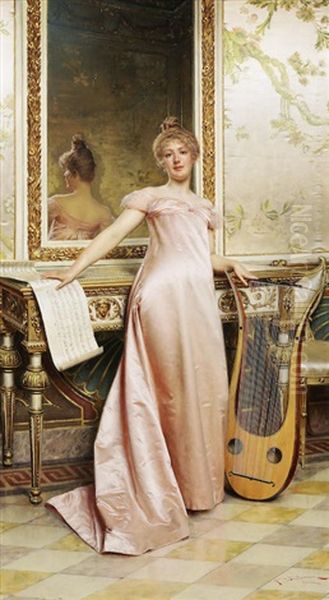
By 1876, his talent and dedication were recognized, and he was officially admitted as a student in the painting department. The Florentine artistic scene of the late 19th century was vibrant, though largely conservative, with a strong adherence to academic principles. Artists like Giovanni Fattori, a leading figure of the Macchiaioli group (who were, in a sense, Italian counterparts to the French Impressionists, though distinct in style), offered a more modern, plein-air approach, but the dominant trend within the Academy remained focused on historical subjects, portraiture, and meticulously finished genre scenes. Soulacroix's training would have instilled in him a profound respect for craftsmanship and a mastery of representational techniques.
Development of a Signature Style: The "Silks and Satins" Painter
After completing his studies, Soulacroix established himself as a professional artist, primarily based in Florence. He quickly developed a distinctive style that catered to the tastes of a wealthy international clientele. His paintings are characterized by an almost photographic realism in the depiction of textures, particularly the lustrous sheen of silk, the rich depth of velvet, and the delicate intricacy of lace. This extraordinary ability to render fabrics with such tactile verisimilitude led some to affectionately refer to artists specializing in such detailed costume pieces as belonging to the "Silks and Satins School," a descriptive term rather than a formal movement.
Soulacroix's subject matter often revolved around elegant ladies in opulent domestic settings. These were not grand historical narratives in the vein of Jacques-Louis David or dramatic mythological scenes like those of Peter Paul Rubens. Instead, Soulacroix focused on intimate moments of leisure and quiet sophistication: women engaged in conversation, reading, playing musical instruments, or enjoying a cup of tea. These scenes, often set in sumptuously decorated Rococo or Neoclassical interiors, exude an air of refined grace and romantic nostalgia.
His figures are typically idealized, possessing delicate features and graceful postures. The compositions are carefully balanced, and the lighting is often soft and diffused, enhancing the richness of the colors and the textures of the materials. While some works depict contemporary Victorian or Edwardian elegance, many of his most sought-after pieces evoke the aristocratic charm of the 18th century, a period that held a particular fascination for the Gilded Age elite. This romantic historicism was a popular trend, also seen in the works of contemporaries like Jean-Léon Gérôme in his historical reconstructions, or Lawrence Alma-Tadema with his scenes of classical antiquity, though Soulacroix's focus was more on intimate, domestic charm.
Key Themes and Subjects
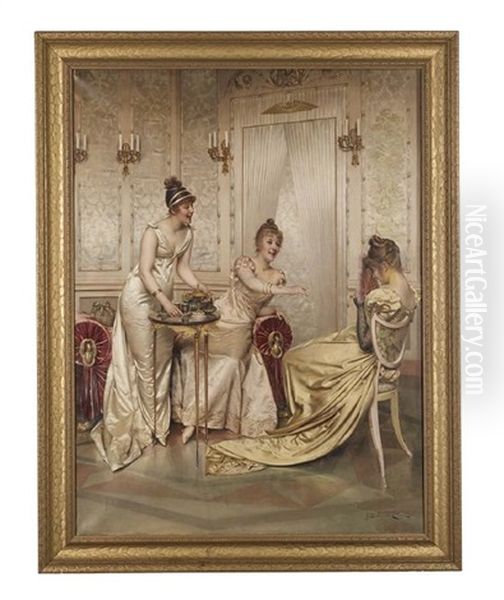
The recurring themes in Soulacroix's art reflect the aspirations and aesthetic preferences of his patrons. Elegance, romance, and an appreciation for beauty and craftsmanship are paramount. His genre scenes often tell subtle stories, hinting at flirtations, quiet contemplation, or the gentle rhythms of upper-class domestic life. These are not works intended to provoke or challenge, but rather to delight the eye and evoke a sense of refined pleasure.
Portraiture was another significant aspect of his oeuvre. He was sought after for his ability to capture not only a likeness but also the sitter's social standing and refined character, often enhanced by the luxurious attire and settings he so masterfully depicted. His skill in rendering the intricate details of fashion—the drape of a gown, the shimmer of pearls, the delicacy of a fan—made his portraits particularly appealing.
The interiors themselves are often as much a subject as the figures within them. Gilded mirrors, ornate furniture, plush carpets, and delicate porcelain are rendered with the same meticulous care as the human figures and their attire. This attention to the material world underscores the opulence and cultivated taste associated with his subjects. Artists like Jean Béraud captured the bustling social life of Paris outdoors, while Soulacroix offered a glimpse into the private, gilded cages of high society.
Notable Patrons and International Acclaim
Frédéric Soulacroix's talent did not go unnoticed. He cultivated a successful career, working primarily for private clients rather than seeking official Salon recognition in Paris, though his style was certainly in line with the popular academic art of the era. His patrons were drawn from an international elite, including wealthy individuals from the United States, Great Britain, Germany (particularly Munich, a significant art center), South Africa, and Canada. This widespread appeal speaks to the universal allure of his elegant and meticulously crafted paintings.
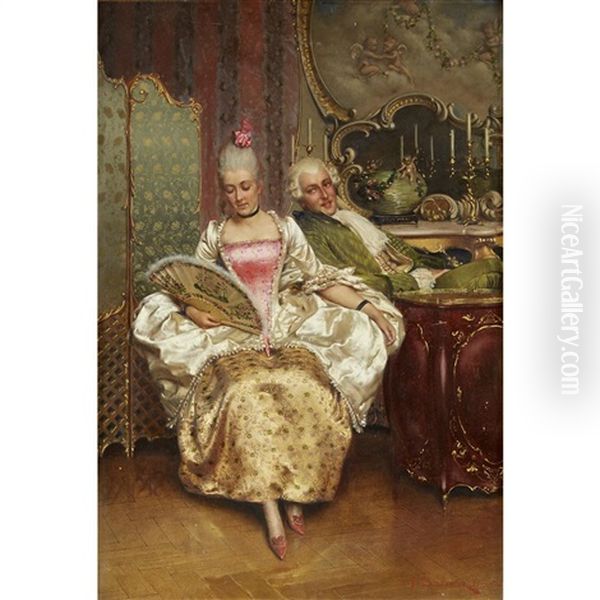
Among his most distinguished sitters were members of royalty. He famously painted a portrait of Queen Margherita of Savoy, the wife of King Umberto I of Italy. Queen Margherita was a celebrated figure, known for her style and cultural patronage, and a portrait by Soulacroix would have been a significant commission. He also received commissions from Asian royalty, including portraits of the King of Siam (Thailand) and his brother, Prince Sanbasaska. These prestigious commissions further solidified his reputation as a painter of international standing, capable of satisfying the exacting demands of the highest echelons of society. His work can be compared to that of other society portraitists of the era, such as Giovanni Boldini or John Singer Sargent, though Soulacroix's style was generally more polished and less overtly bravura in its brushwork than that of Boldini or Sargent.
Representative Masterpieces
While many of Soulacroix's works are in private collections, several titles are frequently associated with his name and exemplify his characteristic style.
_The Tea Party_ (or _Afternoon Tea_): This subject, which he painted in several variations, is quintessential Soulacroix. It typically depicts elegantly dressed ladies in a lavishly decorated drawing-room, engaged in the ritual of afternoon tea. The paintings are a symphony of textures: the sheen of silk gowns, the glint of silver teapots, the delicate patterns of porcelain cups, and the rich wood of antique furniture. The atmosphere is one of refined sociability and quiet grace. These scenes capture the essence of Victorian and Belle Époque high society, where such gatherings were important social rituals.
_Her Music Lesson_: Another popular theme, this often features a young woman at a piano or with another musical instrument, perhaps accompanied by an admirer or a teacher. These works highlight the accomplishments expected of well-bred young ladies and provide an opportunity for Soulacroix to showcase his skill in depicting elegant interiors, fashionable attire, and the romantic ambiance of a shared cultural pursuit. The focused expressions and graceful postures of the figures add to the charm of these compositions.
_Flirtation_ or _The Declaration_: Many of his works carry titles that suggest a romantic narrative, however subtle. Scenes of a gentleman paying court to a lady, or a shared glance over a book or a piece of embroidery, are common. These paintings tap into the romantic sensibilities of the era, offering charming vignettes of courtship and affection, always rendered with his signature elegance and attention to detail. The delicate emotional interplay is often as important as the visual splendor.
Other works, often titled descriptively like _An Amusing Letter_, _The Suitor_, or _A Quiet Afternoon_, all share the common threads of exquisite technical skill, a focus on luxurious detail, and the depiction of an idealized, elegant world. His ability to make silk shimmer and velvet glow on canvas was unparalleled among many of his contemporaries.
Contemporaries and Artistic Circles in Florence and Beyond
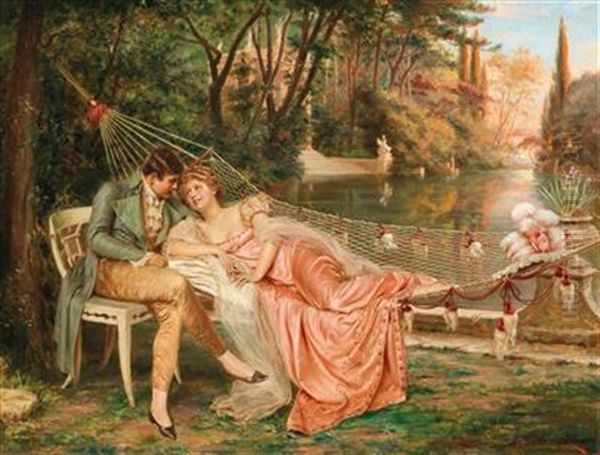
Frédéric Soulacroix worked during a period of significant artistic diversity. While Impressionism, Post-Impressionism, and early Modernist movements were challenging traditional artistic conventions elsewhere in Europe, academic art continued to thrive, particularly in Italy and among conservative patrons internationally.
In Florence, Soulacroix was part of an artistic milieu that included other painters specializing in similar costume or genre pieces. Vittorio Reggianini (1858-1938), a contemporary and fellow Florentine academic painter, also specialized in elegant interior scenes, often depicting figures in 18th-century attire, much like Soulacroix. Their works share a similar aesthetic of refined detail and romantic nostalgia. Federico Andreotti (1847-1930) was another notable Florentine artist whose work often featured fashionable young women in luxurious settings, indicating a shared taste and market for such subjects. Arturo Ricci (1854-1919) also excelled in depicting Rococo-revival scenes of courtship and leisure, filled with meticulously rendered costumes and antiques. These artists, while individual in their nuances, collectively catered to a demand for beautifully crafted, historically evocative, and charmingly romantic paintings.
Beyond Italy, the taste for such polished academic art was widespread. In France, artists like William-Adolphe Bouguereau continued to produce highly finished mythological and genre scenes. In England, the aforementioned Lawrence Alma-Tadema created incredibly detailed visions of ancient Rome and Egypt, while James Tissot chronicled the fashionable society of London and Paris with a keen eye for detail and social nuance, though with a more contemporary feel than many of Soulacroix's historical evocations. Even the great portraitist John Singer Sargent, while possessing a more dynamic and modern brushwork, often depicted his sitters within opulent settings that spoke to their status, a concern shared by Soulacroix's patrons.
The enduring appeal of Soulacroix's work, and that of his peers in the "Silks and Satins" vein, lay in its escapism, its celebration of beauty, and its impeccable craftsmanship. In an era of rapid industrialization and social change, these paintings offered a glimpse into a world of timeless elegance and refined pleasure.
The Broader Context: Academic Art in the Late 19th Century
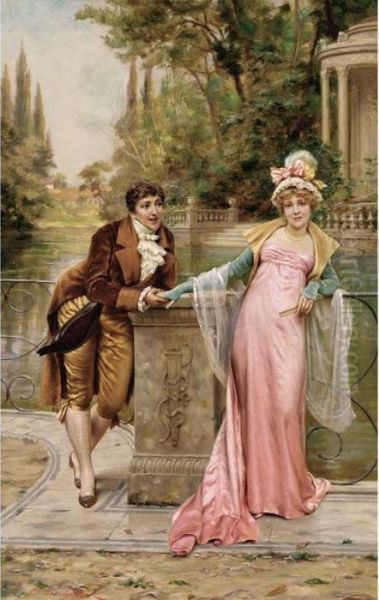
To fully appreciate Soulacroix, it's important to understand the context of academic art in the late 19th century. Art academies, like the one in Florence, were the traditional gatekeepers of artistic standards. They emphasized a curriculum based on drawing from classical sculpture and live models, the study of anatomy and perspective, and the emulation of Old Masters such as Raphael or Titian. The goal was to achieve a high degree of technical proficiency and to create art that was morally uplifting, historically informative, or aesthetically pleasing according to established conventions.
The official Salons, particularly in Paris, were the primary venues for artists to exhibit their work and gain recognition. While avant-garde movements like Impressionism (with artists such as Claude Monet, Edgar Degas, and Pierre-Auguste Renoir) were gaining traction and challenging academic norms with their focus on capturing fleeting moments, contemporary life, and the effects of light and color, academic art remained highly popular with the public and with wealthy patrons.
Soulacroix's art fits comfortably within this academic tradition, prioritizing meticulous finish, idealized beauty, and narrative clarity. His choice of historical or elegantly contemporary genre scenes aligned with the tastes of a bourgeoisie and aristocracy who valued art that was both decorative and reflective of their refined sensibilities. Unlike the Impressionists who often sought to capture the immediacy of modern life, or Post-Impressionists like Vincent van Gogh or Paul Gauguin who explored subjective emotional expression, Soulacroix and his academic colleagues offered a more polished, idealized, and often nostalgic vision of the world.
Soulacroix's Place in Art History
In art historical narratives that often prioritize the avant-garde, academic painters like Soulacroix have sometimes been overlooked or dismissed as merely conservative. However, a more nuanced understanding recognizes the immense skill, cultural significance, and enduring appeal of their work. Soulacroix was a master craftsman, possessing an extraordinary technical facility that allowed him to create illusions of breathtaking realism, particularly in the rendering of fabrics and textures.
His paintings are valuable historical documents, offering insights into the tastes, aspirations, and social customs of the late 19th and early 20th-century elite. They reflect a fascination with historical romance, a desire for beauty and elegance in domestic surroundings, and an appreciation for meticulous artistry. The fact that his works commanded high prices and were sought after by an international clientele attests to their contemporary value.
Today, there is a renewed appreciation for academic art of this period. Museums and collectors are increasingly recognizing the quality and historical importance of artists who worked within, rather than against, the established traditions of their time. Soulacroix's paintings continue to perform well at auction, demonstrating their lasting appeal to collectors who admire their beauty, craftsmanship, and the charming world they depict. He may not have been a revolutionary, but he was an exceptionally skilled practitioner of a particular kind of art that brought immense pleasure to his contemporaries and continues to do so today.
Legacy and Enduring Influence
While Frédéric Soulacroix did not found a school or inspire a major artistic movement in the way that avant-garde figures did, his legacy lies in the exquisite quality of his individual works and his contribution to the tradition of elegant genre painting. His paintings remain highly sought after by collectors of 19th-century European art, admired for their technical brilliance and their charming evocation of a bygone era of grace and luxury.
His influence can be seen in the continued appreciation for detailed, realistic painting and in the enduring appeal of romantic and historical subjects. Contemporary artists who specialize in realism or who draw inspiration from historical aesthetics can find a kindred spirit in Soulacroix's dedication to craft and beauty. For instance, the mention of a modern artist like Arianna Bongato referencing Soulacroix's romantic scenes in her work indicates that his visual language still resonates.
Furthermore, his body of work serves as a valuable resource for social historians and costume designers, offering meticulously detailed representations of fashion and interior décor from both the 18th century (as imagined through a 19th-century lens) and his own time. The precision with which he rendered every fold of fabric, every piece of lace, and every gleaming surface provides a rich visual archive.
Conclusion: An Artist of Refined Virtuosity
Frédéric Soulacroix (1858-1933) carved a distinguished niche for himself as a painter of elegant society, romantic encounters, and luxurious interiors. Born into an artistic family and rigorously trained at the Florence Academy, he developed a signature style characterized by meticulous detail, a particular mastery in rendering rich textiles, and a preference for subjects that exuded charm and sophistication. His patrons, an international array of wealthy individuals and even royalty, sought his work for its beauty, its craftsmanship, and its ability to transport the viewer to a world of idealized grace.
While he operated within the conservative framework of academic art, standing apart from the contemporaneous modernist upheavals, Soulacroix achieved a level of technical perfection and aesthetic refinement that commands respect. His paintings, from intimate tea parties to quiet musical interludes, continue to enchant viewers with their timeless elegance and the sheer virtuosity of their execution. As an art historian, one must acknowledge him as a significant figure in his specific genre, a master of his craft whose works offer a delightful window into the opulent tastes and romantic sensibilities of the Gilded Age. His art remains a testament to the enduring human desire for beauty, skillfully captured and exquisitely presented.